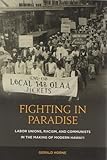Fighting in Paradise : Labor Unions, Racism, and Communists in the Making of Modern Hawai'i / Gerald Horne.
Material type: TextPublisher: Honolulu : University of Hawaii Press, [2011]Copyright date: ©2011Description: 1 online resource (488 p.) : 16 b&w imagesContent type:
TextPublisher: Honolulu : University of Hawaii Press, [2011]Copyright date: ©2011Description: 1 online resource (488 p.) : 16 b&w imagesContent type: - 9780824835026
- 9780824860219
- 331.8809969 22
- HD6517.H3 H67 2011eb
- online - DeGruyter
- Issued also in print.
| Item type | Current library | Call number | URL | Status | Notes | Barcode | |
|---|---|---|---|---|---|---|---|
 eBook
eBook
|
Biblioteca "Angelicum" Pont. Univ. S.Tommaso d'Aquino Nuvola online | online - DeGruyter (Browse shelf(Opens below)) | Online access | Not for loan (Accesso limitato) | Accesso per gli utenti autorizzati / Access for authorized users | (dgr)9780824860219 |
Frontmatter -- Contents -- A Prefatory Note -- Introduction -- Chapter 1. Confronting Colonial Hawai'i -- Chapter 2. An Apartheid Archipelago? -- Chapter 3. The Race of War -- Chapter 4. The Labor of War -- Chapter 5. Sugar Strike -- Chapter 6. Red Scare Rising -- Chapter 7. Purge -- Chapter 8. Surge? -- Chapter 9. State of Anxiety? -- Chapter 10. Stevedores Strike -- Chapter 11. Racism-and Reaction -- Chapter 12. Strife and Strikes -- Chapter 13. Radicalism on Trial -- Chapter 14. The Trials of Racism and Radicalism -- Chapter 15. Upheaval -- Chapter 16. Radicals Advance-and Retreat -- Chapter 17. Toward Statehood -- Notes -- Index
restricted access online access with authorization star
http://purl.org/coar/access_right/c_16ec
Powerful labor movements played a critical role in shaping modern Hawaii, beginning in the 1930s, when International Longshore and Warehousemen's Union (ILWU) representatives were dispatched to the islands to organize plantation and dock laborers. They were stunned by the feudal conditions they found in Hawaii, where the majority of workers-Hawaiian, Japanese, Chinese, and Filipino in origin-were routinely subjected to repression and racism at the hands of white bosses.The wartime civil liberties crackdown brought union organizing to a halt; but as the war wound down, Hawaii workers' frustrations boiled over, leading to an explosive success in the forming of unions. During the 1950s, just as the ILWU began a series of successful strikes and organizing drives, the union came under McCarthyite attacks and persecution. In the midst of these allegations, Hawaii's bid for statehood was being challenged by powerful voices in Washington who claimed that admitting Hawaii to the union would be tantamount to giving the Kremlin two votes in the U.S. Senate, while Jim Crow advocates worried that Hawaii's representatives would be enthusiastic supporters of pro-civil rights legislation.Hawaii's extensive social welfare system and the continuing power of unions to shape the state politically are a direct result of those troubled times. Based on exhaustive archival research in Hawaii, California, Washington, and elsewhere, Gerald Horne's gripping story of Hawaii workers' struggle to unionize reads like a suspense novel as it details for the first time how radicalism and racism helped shape Hawaii in the twentieth century.
Issued also in print.
Mode of access: Internet via World Wide Web.
In English.
Description based on online resource; title from PDF title page (publisher's Web site, viewed 02. Mrz 2022)


